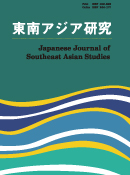6 巻, 1 号
選択された号の論文の20件中1~20を表示しています
- |<
- <
- 1
- >
- >|
-
1968 年6 巻1 号 p. 1
発行日: 1968/09/20
公開日: 2019/06/18
PDF形式でダウンロード (107K)
論文
-
1968 年6 巻1 号 p. 2-35
発行日: 1968/09/20
公開日: 2019/06/18
PDF形式でダウンロード (1624K) -
1968 年6 巻1 号 p. 36-54
発行日: 1968/09/20
公開日: 2019/06/18
PDF形式でダウンロード (1811K) -
1968 年6 巻1 号 p. 55-72
発行日: 1968/09/20
公開日: 2019/06/18
PDF形式でダウンロード (2108K) -
1968 年6 巻1 号 p. 73-167
発行日: 1968/09/20
公開日: 2019/06/18
PDF形式でダウンロード (8331K) -
1968 年6 巻1 号 p. 168-176
発行日: 1968/09/20
公開日: 2019/06/18
PDF形式でダウンロード (633K)
報告
-
1968 年6 巻1 号 p. 177-183
発行日: 1968/09/20
公開日: 2019/06/18
PDF形式でダウンロード (716K) -
1968 年6 巻1 号 p. 184-192
発行日: 1968/09/20
公開日: 2019/06/18
PDF形式でダウンロード (1240K)
現地通信
-
1968 年6 巻1 号 p. 193-198
発行日: 1968/09/20
公開日: 2019/06/18
PDF形式でダウンロード (866K) -
1968 年6 巻1 号 p. 199-203
発行日: 1968/09/20
公開日: 2019/06/18
PDF形式でダウンロード (667K) -
1968 年6 巻1 号 p. 204-208
発行日: 1968/09/20
公開日: 2019/06/18
PDF形式でダウンロード (702K) -
1968 年6 巻1 号 p. 208-213
発行日: 1968/09/20
公開日: 2019/06/18
PDF形式でダウンロード (783K) -
1968 年6 巻1 号 p. 213-227
発行日: 1968/09/20
公開日: 2019/06/18
PDF形式でダウンロード (2109K)
図書紹介
-
1968 年6 巻1 号 p. 228
発行日: 1968/09/20
公開日: 2019/06/18
PDF形式でダウンロード (163K) -
1968 年6 巻1 号 p. 229
発行日: 1968/09/20
公開日: 2019/06/18
PDF形式でダウンロード (195K) -
1968 年6 巻1 号 p. 229-230
発行日: 1968/09/20
公開日: 2019/06/18
PDF形式でダウンロード (315K) -
1968 年6 巻1 号 p. 230-231
発行日: 1968/09/20
公開日: 2019/06/18
PDF形式でダウンロード (256K) -
1968 年6 巻1 号 p. 231
発行日: 1968/09/20
公開日: 2019/06/18
PDF形式でダウンロード (134K)
彙報
-
原稿種別: 付録等
1968 年6 巻1 号 p. 232-241
発行日: 1968/09/20
公開日: 2019/06/18
PDF形式でダウンロード (545K)
あとがき
-
原稿種別: 付録等
1968 年6 巻1 号 p. 242
発行日: 1968/09/20
公開日: 2019/06/18
PDF形式でダウンロード (65K)
- |<
- <
- 1
- >
- >|
